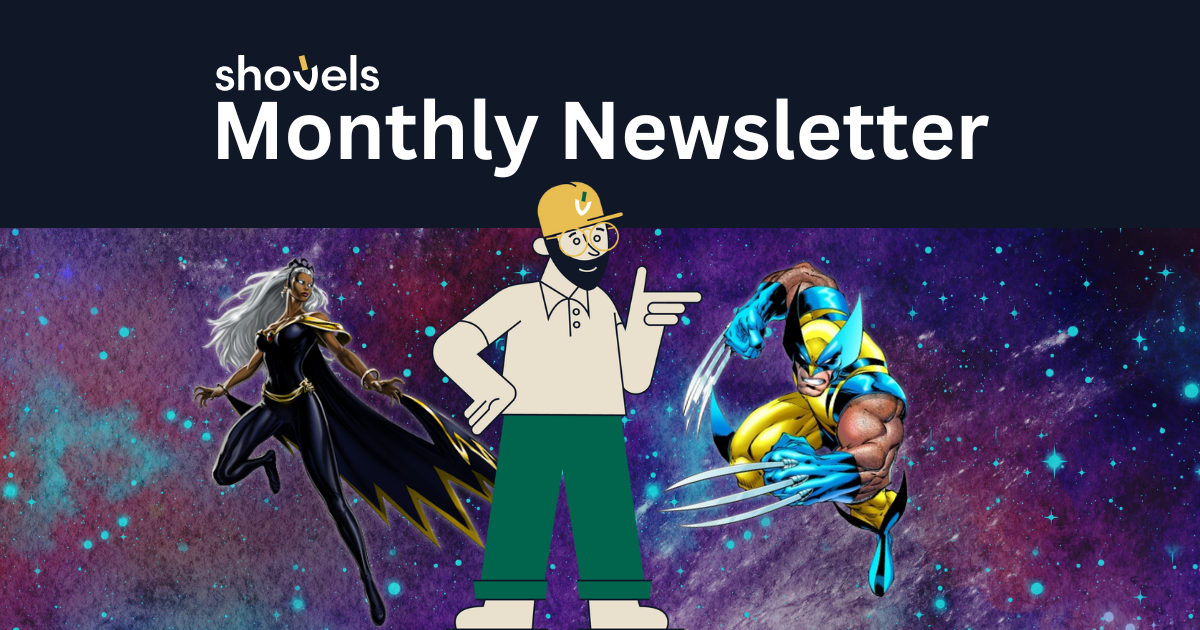A few things are top of mind for me right now, but the common thread is this: We’re quickly moving into what feels like the next version of Shovels. I’ll try to share what that means!
But first, some vital stats:
- 10M new permits added in September — our most ever, BY FAR
- 190K new contractors added in September and tons of contact info enrichment
- Our first “offline” jurisdictions are now fully online: Cook County, IL and North Oak Ridge, TX — and there are 100 more in the hopper
In this newsletter I’ll share more about our dual operations, Team Wolverine and Team Storm, and how this leads to the next major shift at Shovels.
X-Men (and Women)
We named our data collection teams after two X-Men characters, Wolverine and Storm. Why comic books? I dunno. Maybe because I don’t watch sports?
It also felt appropriate. Wolverine is self-healing, he scrapes, he’s strong and can be aggressive when he needs to be. This is our online operation, the one that finds public building permits on the internet and compiles them for processing.
Storm is everything else. She goes broad, controlling large swaths of territory that Wolverine can’t touch. Ultimately, Storm will be responsible for far more than just building permits. (That’s a clue for what’s coming!)
Together, Storm and Wolverine encompass everything that Shovels is and will become. At scale, these will be big teams. We need really smart humans to give our AI coding support direction, correct its mistakes, and keep our codebase pristine. I still believe we have the best government data collection in the industry: AI-native, self-healing data collection, fine-tuned for local government websites.
That’s a mouthful, but who else can say it? It’s the most Shovels thing ever.
And when the permits are not online, what do we do?
We pick up the phone and call, obviously!
In the age of AI, this is the most arcane thing ever, but there’s an elegance to it, too. I love that Storm is so manual. It’s becoming our biggest long-term advantage. Even with agentic support, there will be many humans involved in this effort. Team Storm will be quite large at scale.
I share this knowing that some in our industry will copy these ideas. That’s fine. We’re already thinking five steps beyond all this.
I want you to know that this is happening so you can feel confident that we are and will continue to be the best at what we do.
The next big thing
Storm and Wolverine are the engine. The next big thing is the destination.
It’s not lost on me that we have not put the AI into Shovels.AI for our customers. We don’t have the AI wizardry that a lot of tech companies have been running for years: plain English prompting, chat bots, and other generative and agentic AI tools.
Don’t worry, folks. It’s happening at Shovels, too. We’ve been waiting to get it right, and the chat interface that we can build on top of has finally arrived! The team has our own internal Shovels MCP server up and running and we are actively battle-testing a purpose-built chat interface that will feature the following:
- LOTS of graphs. We know you want to visualize the data, and this new tool is great at guessing which types of charts will work best for your query.
- Follow up suggestions. It’s really fun to get asked smart, clarifying follow-up questions and just be able to click on them.
- Downloads. This is the trickier one — we want to let you download the data without this feature getting out of hand. Fixing the guardrails on this one is a challenge.
- Generalized MCP. We’re building on top of our Shovels MCP server. Shouldn’t you be able to do the same? I think so. It’s just a matter of, again, choosing the limits and making sure we can enforce them.
We have a small, and already outdated, page for this offering, named Chuck. Drop your email in the form to let us know you’re interested!
The already new and improved Chuck (I mean, we never really launched the prototype) will get released sometime this quarter. I’m sure you’ll read about it here!
Things to do with permits: find roof age
We’re getting more inbounds asking about roof age for solar, roof age for financing, roof age for insurance. All kinds of applications for roof age.
With building permits, of course, you can look for roofing changes: new roofs (re-roofs) and partial upgrades. You can also be clever and include new builds, major remodels (sometimes the new roof gets a mention, but often it does not) and additions.
At the Esri conference we saw some really cool companies using satellite imagery and even Google Street View to figure out if a new roof has gone in. Someday, we’ll leverage images to corroborate building permit statuses and identify work being done off-permit. I think this will be a very important addition to Shovels.
In the meantime, we use our existing data, a combination of permits and tax assessor files, to come up with our own estimate of roof age across all of the tens of millions of roofs in our permit jurisdictions.
To tie this back to the point I opened with about the evolution of Shovels, and to answer the question, “What’s roofs got to do, got to do with it?”, I offer this: It is about combining multiple datasets that maybe haven’t been merged and processed together before at this new scale and with this new technology. The more local government data we add, the more cool stuff like this we can do.
If you want a roof age sample, reach out!


